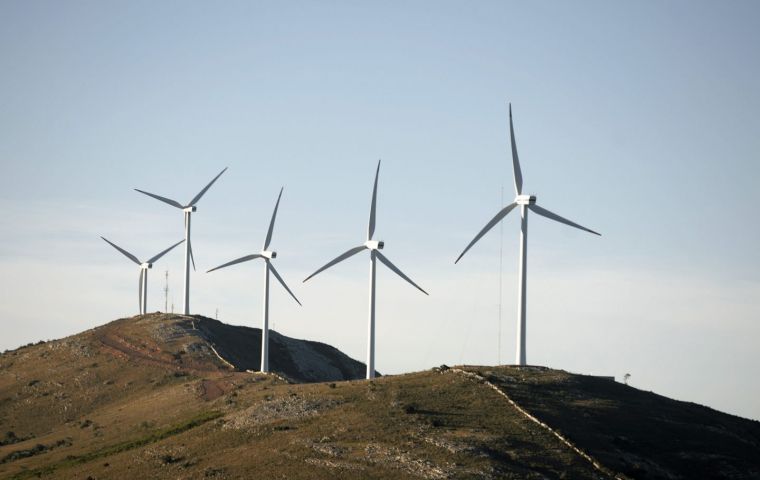MercoPress. South Atlantic News Agency
Uruguay saves money with environment-friendly electricity
 Uruguay supplies electricity to Brazil and Argentina thanks to wind generation
Uruguay supplies electricity to Brazil and Argentina thanks to wind generation Uruguay has become the second country in the world when it comes down to wind-generated electricity, thanks to 43 eolic parks which produce a third (33%) of the electricity consumed nationwide, which has represented savings above US $ 125 million in 2020 alone.
Denmark is the only country surpassing Uruguay in wind-energy production. Behind Uruguay and in that order come Ireland, Germany, Greece, Spain, United Kingdom, Portugal, Australia, Holland, Switzerland and Belgium.
The South American country also produces 3% of its electricity consumption through solar plants. The rest of Uruguay's electricity derives from hydro (29%), firewood and biomass waste (23%), diesel (10%), and fuel oil (2%), Infobae reported.
The year 2020 was the first in which wind power surpassed hydro in the country's history. “2020 was the driest year and that circumstance occurred that, in particular, the contribution from wind power was greater because we had less water,” Fernando Fontana, advisor to the Presidency of UTE (National Administration of Power Plants and Electric Transmission) said.
“Cables cannot store energy, they are not batteries. If there are generators on one side, on the other there must be consumers and the energy balance, second by second, has to be the same. If not, the system becomes unbalanced. “It's like when you ride a bike and you're on a steep slope, you have to keep up your speed,” says Óscar Ferreño, Director of Institutional Relations and Regulation of the Ventus company, an Uruguayan supplier for all stages of renewable energy and infrastructure projects.
Ferreño also insisted that in the absence of a place to store wind and solar energy, they were the first to be dispatched onto the powerlines. If necessary, then hydroelectric power is used. The difference between wind and water is that the latter is saved - in dams, Ferreño added.
UTE President Silvia Emaldi explained that unstorable wind energy surpluses at night are taken by Argentina at a low price. But the energy also goes to Brazil. “They are in a much greater drought situation than we were and they are buying all the energy available from us at market price through the interconnections we have with them,” Emaldi explained, either through the city of Melo or the city of Rivera. “We are exporting those 570 megawatts practically around the clock and this year we have almost no surplus,” she said.
And while mobility in Uruguay still depends largely on fossil fuels, the country is rapidly shifting to an environment-friendly matrix: “We are moving rapidly towards the electrical transformation in mobility, egro is the great challenge we have,” says Walter Verri, undersecretary of the Ministry of Industry, Energy and Mining.
But things need to be done gradually: “If you were to make all cars electric, you'd have to multiply the current electrical system by five,” Ferreño pointed out. In other words, there would have to be six times the number of wind farms currently existing in Uruguay.
In addition to that, “an electric car is not cheap and there are still some other drawbacks to be overcome, such as autonomy,” says Verri.
A study by the Uruguayan Association of Private Generators of Uruguay (AUGPEE) has estimated savings from the incorporation of renewable sources such as wind and solar electricity amounted to over US $ 744 million between 2007 and 2019.
“It is one of the reasons why we have to move towards electric mobility as fast as we can, not only for the care of the environment, there are also economic reasons,” says Verri.
(Source: infobae)




Top Comments
Disclaimer & comment rulesCommenting for this story is now closed.
If you have a Facebook account, become a fan and comment on our Facebook Page!